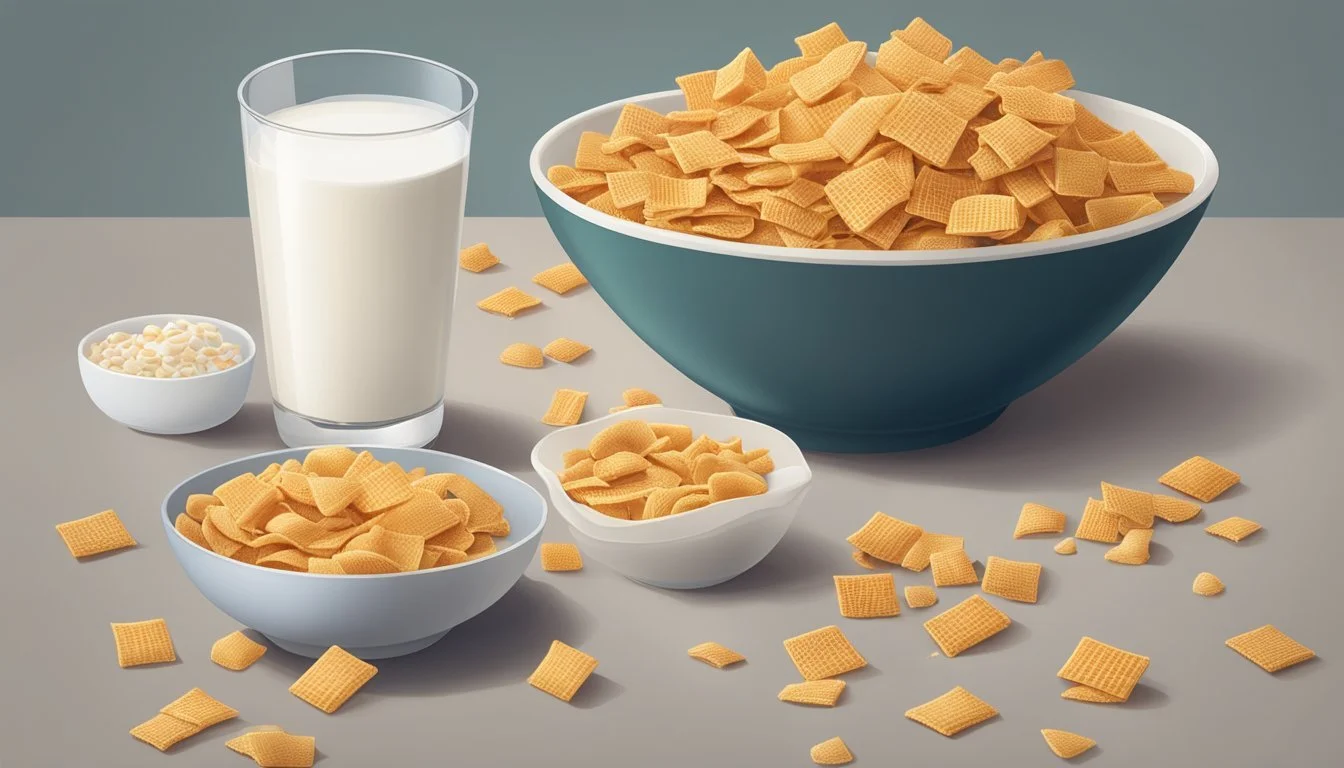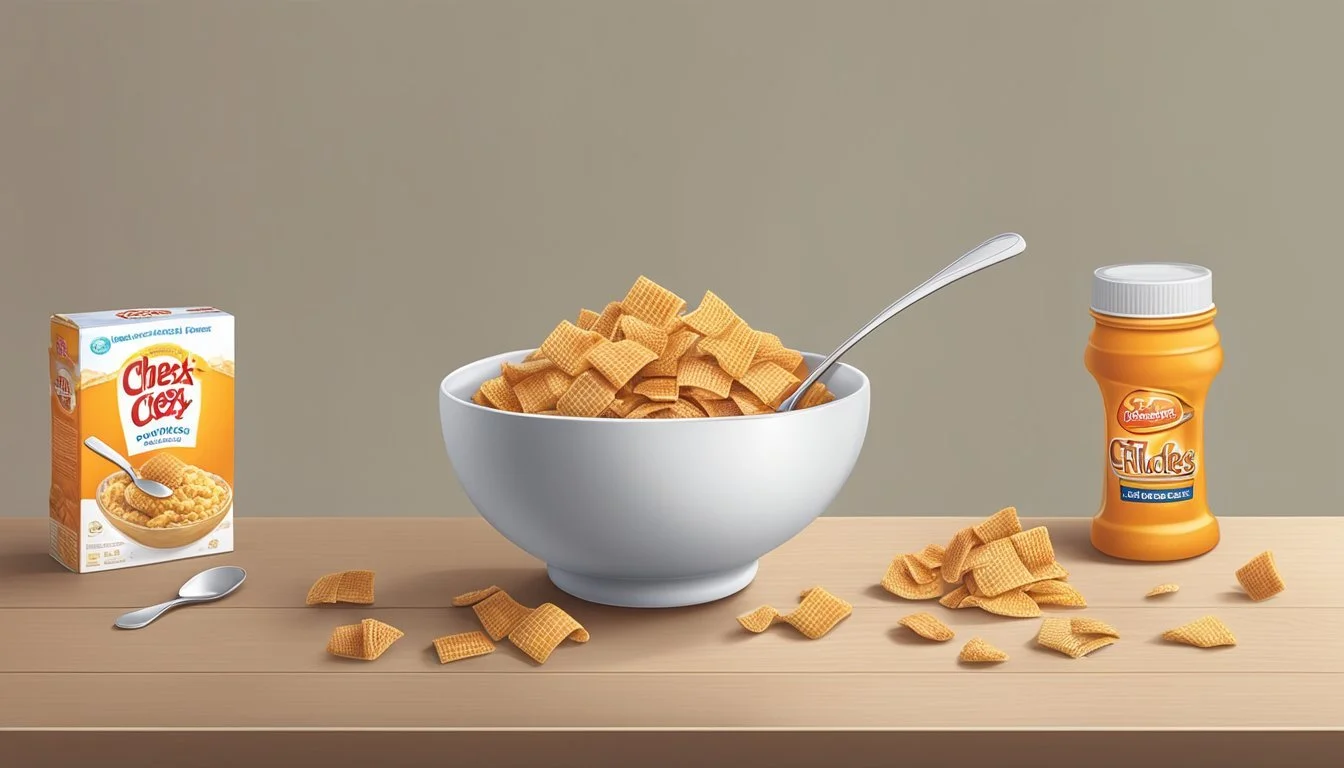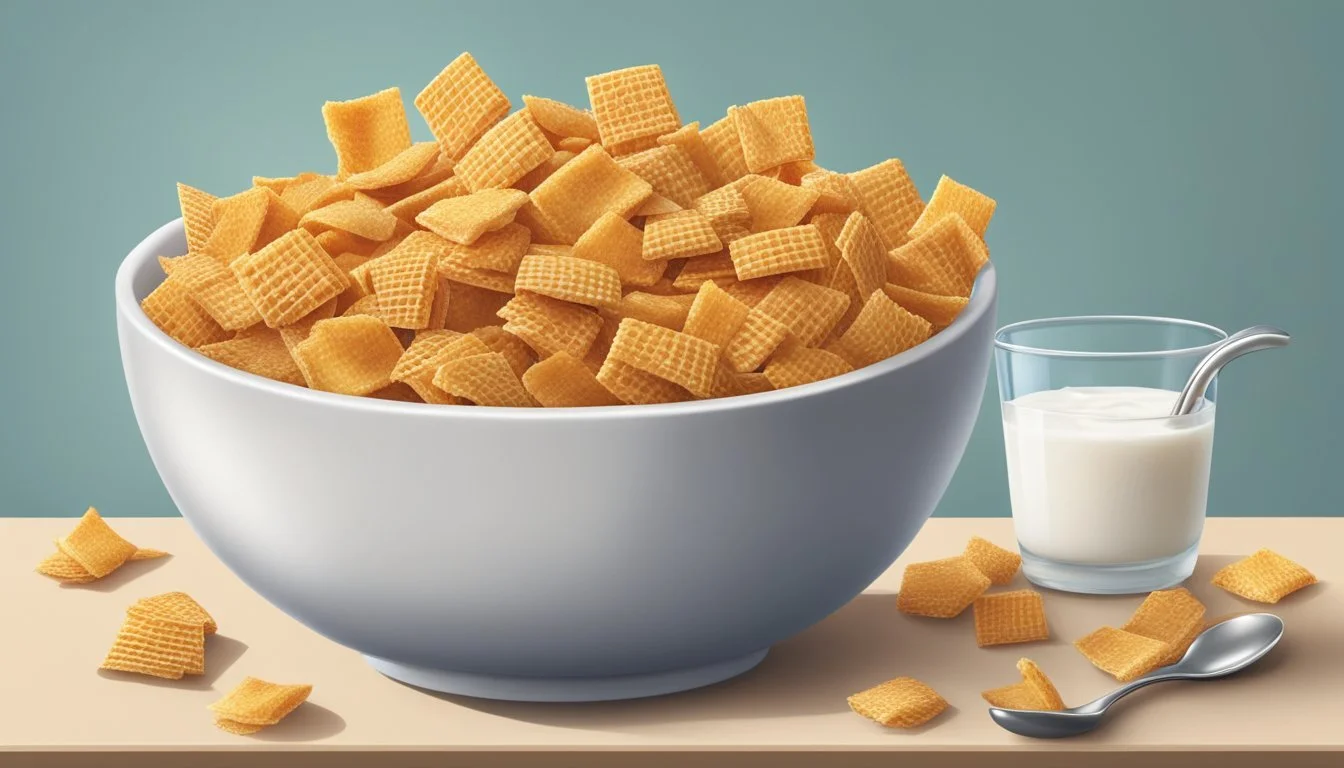Chex vs Frosted Flakes
Comparing Nutrition and Taste
This Article is Part of Our Breakfast Cereal Guide with Details on Chex Nutrition and Frosted Flakes Nutrition
When it comes to deciding between Chex and Frosted Flakes for breakfast, understanding the nutritional differences is key. Wheat Chex contains 17 grams of complex carbohydrates per serving, providing a more sustained energy release compared to Frosted Flakes' 14 grams. For those focused on fiber intake, products like Wheat Chex may offer a better choice due to its higher complex carbohydrate content.
On the other hand, for those who prioritize taste and are perhaps more lenient about sugar content, Frosted Flakes can be an appealing option. The sweet, satisfying crunch of Frosted Flakes has long made it a breakfast favorite, despite its lower nutritional scores in areas like protein and fiber.
Ultimately, the choice between Chex and Frosted Flakes hinges on personal priorities—be it nutritional value or taste satisfaction. Balancing these factors can help make the best choice for your daily breakfast.
History and Evolution
Chex and Frosted Flakes arose from distinct historical contexts, each with innovative marketing strategies that helped secure their place in the breakfast cereal market.
Origins of Chex and Frosted Flakes
Chex, introduced by General Mills in 1937, was originally developed as a wheat-based cereal known for its lattice-like texture. The unique shape made it ideal for both breakfast and various recipes, such as Chex Mix.
Frosted Flakes, on the other hand, were launched by Kellogg's in 1952. The cereal became notable for its sugar-coated corn flakes, appealing to children with its sweet taste and mascot Tony the Tiger, making it a household staple.
Key Developers: General Mills and Kellogg's
General Mills, a major force in the cereal industry, developed Chex as part of their diversified product lineup, which includes Cheerios and Wheaties. Their consistent innovations and marketing have contributed greatly to Chex's enduring popularity.
Kellogg's, led by the visionary Will Keith Kellogg, created Frosted Flakes as a follow-up to their successful Corn Flakes. Kellogg's mastery in branding and promotions not only boosted Frosted Flakes but also made significant impacts with other cereals like Raisin Bran and Special K.
As major players, both companies leveraged clever marketing and strategic product development to influence breakfast habits globally.
Product Overview
Both Chex and Frosted Flakes are popular breakfast cereals offered by different manufacturers, General Mills and Kellogg's respectively. This section will cover what sets these cereals apart in terms of their defining characteristics and nutritional content.
Defining Chex and Frosted Flakes
Chex cereals, manufactured by General Mills, include varieties such as Corn Chex and Wheat Chex. These cereals are known for their square-shaped, lattice-designed pieces. Corn Chex offers 22 grams of complex carbohydrates per serving, while Wheat Chex provides 17 grams. The high fiber content makes Chex a favored choice for those seeking nutritional benefits.
Frosted Flakes, by Kellogg's, feature sugar-coated corn flakes which deliver a sweeter taste. Each serving of Kellogg's Frosted Flakes has 14 grams of complex carbohydrates and 12 grams of added sugar. While it may not offer high fiber content, its flavor appeals broadly, especially to children.
Both cereals offer distinctive tastes and textures, catering to different dietary preferences and nutritional goals. Chex emphasizes wholesome grains and higher fiber, while Frosted Flakes focuses on delivering a sweet and enjoyable breakfast experience.
Nutritional Comparison
Both Chex and Frosted Flakes offer distinct nutritional profiles. The comparison highlights differences in macronutrients, vitamins, minerals, sugar, and fiber content.
Macronutrient Profile
Chex cereals typically provide a balanced macronutrient profile. For instance, Corn Chex has 22.0 grams of complex carbohydrates, including whole grains. It also contains around 2 grams of protein per serving and is low in fat, making it a healthy option.
Frosted Flakes, on the other hand, are higher in sugars but tend to be lower in protein, featuring about 14.0 grams of complex carbohydrates and fewer grams of protein per serving compared to Chex. Frosted Flakes also have a higher calorie count primarily due to the added sugars.
Vitamins and Minerals Content
Chex varieties are often fortified with essential vitamins and minerals. For example, Wheat Chex can be rich in B vitamins, iron, and folic acid. These cereals often include vital micronutrients like zinc and magnesium due to the use of whole grains, providing health benefits such as improved energy metabolism and immune support.
Frosted Flakes are also fortified but tend to focus more on vitamins like vitamin D and A. They may offer substantial amounts of iron and might also include calcium to aid in bone health. Despite its sugary reputation, the added vitamins and minerals make it a viable option for meeting daily nutritional requirements.
Sugar and Fiber Content
Chex cereals tend to have a balanced approach towards sugar and fiber. For example, a serving of Cinnamon Chex contains about 8 grams of sugar and provides a moderate amount of dietary fiber. Whole grain varieties of Chex usually contain more fiber which aids in digestion and helps maintain a healthy weight.
Frosted Flakes are known for their high sugar content, with higher grams per serving compared to Chex. This can raise concerns over dental health and weight gain. Frosted Flakes typically contain less dietary fiber, which may limit their satiety value and digestive benefits compared to more fibrous cereals like Wheat or Corn Chex.
Health Considerations
When comparing Chex and Frosted Flakes from a health perspective, it's important to consider aspects such as fiber content, sugar levels, and dietary suitability. Each cereal has unique characteristics that cater to different health priorities.
Benefits of a Balanced Breakfast
A balanced breakfast sets the tone for the day and includes a mix of carbohydrates, proteins, and fiber. Chex offers a range of flavors with varying benefits. For example, Wheat Chex has 8 grams of fiber per serving, making it a robust choice for those needing higher fiber intake.
Frosted Flakes, on the other hand, contains 1 gram of fiber per serving, which is significantly lower. While Frosted Flakes provide quick energy due to their higher sugar content (11 grams per serving), Chex varieties generally have lower sugar levels, which prevents morning sugar spikes and crashes.
Impact on Weight Management
For individuals focusing on weight management, Chex cereals often provide a better option due to their lower sugar content. High fiber options, like Wheat Chex, can promote feelings of fullness, reducing the likelihood of mid-morning snacking.
Comparatively, Frosted Flakes contain higher sugar and fewer complex carbohydrates. This composition can lead to quicker hunger pangs. On the caloric front, Frosted Flakes are also more calorie-dense, which might not be ideal for those managing calorie intake.
Suitability for Restricted Diets
Dietary restrictions play a crucial role in cereal selection. Chex cereals excel in this area, with several gluten-free options available, such as Corn Chex and Rice Chex. This makes them suitable for individuals with gluten intolerance or celiac disease.
Frosted Flakes, crafted primarily from corn, do not usually cater to gluten-free needs as effectively. Additionally, Chex cereals tend to have simpler ingredient lists with fewer additives, beneficial for those trying to avoid certain food additives or allergens.
In conclusion, while both cereals have merits, Chex often aligns better with specific health goals and dietary needs, offering a broader range of benefits through its various flavors and ingredient compositions.
Consumer Guidance
When choosing between Chex and Frosted Flakes, it's important to consider factors like nutrient content and serving sizes. Proper serving size adherence can influence the overall health impact of these breakfast cereals.
Choosing Between Chex and Frosted Flakes
Chex and Frosted Flakes have distinct nutrient profiles that can guide consumer choices.
Wheat Chex, for instance, contains 17 grams of complex carbohydrates per serving, which provides sustained energy release. It's a whole-grain cereal, often high in fiber, aiding in digestion and promoting satiety.
Frosted Flakes features 14 grams of complex carbohydrates but includes higher sugar content. It may appeal more to those looking for a sweeter taste experience. However, it lacks the fiber richness of Chex. The higher sugar content may impact blood sugar levels and could be less desirable for individuals monitoring their sugar intake.
Nutrient comparisons reveal differences in fat, sodium, and protein content, guiding consumers based on dietary needs and preferences. It's essential to consider these variances when selecting a cereal that aligns with one's health goals.
Serving Size Recommendations
Adhering to recommended serving sizes is crucial.
For Wheat Chex, the standard serving size is typically 1 cup, which balances nutrient intake and keeps calorie consumption in check. This serving weighs around 31 grams, offering a nutritional profile conducive to a balanced diet.
Frosted Flakes, on the other hand, often suggest a 3/4 cup serving size, weighing approximately 29 grams. This size manages calorie and sugar intake but still provides a satisfying portion.
The FDA recommends limiting added sugars to less than 10% of daily calories. By following the serving size recommendations, consumers can enjoy their chosen breakfast cereal without exceeding these guidelines. Accurate serving sizes help maintain a balanced diet while enjoying the flavors and benefits of these cereals.
Market Presence and Availability
Both Chex and Frosted Flakes are significant players in the breakfast cereal market, each backed by strong brands and widely available across various retail channels.
Branding and Market Competition
Frosted Flakes, produced by Kellogg's, has a long-standing presence in the market since its introduction in 1952. It's well-known for its mascot, Tony the Tiger, and its catchy slogan, "They're Gr-r-reat!" This branding has helped Kellogg's maintain a significant market share.
Chex, under the umbrella of General Mills, also enjoys a diversified product line. It offers varieties such as Rice Chex, Wheat Chex, and Corn Chex. Unlike Frosted Flakes, Chex has positioned itself as a versatile cereal, often used in recipes for snacks like Chex Mix.
In terms of competition, Frosted Flakes leads with its sugary flavor appealing to children and adults alike. Meanwhile, Chex emphasizes its healthier options, catering to consumers looking for less sugar and more dietary fiber. Brands such as Walmart's Market Pantry may also present competition with their more budget-friendly cereal options.
Availability in Retail
Frosted Flakes is ubiquitously available in grocery stores and major retail chains like Walmart and Target. Its consistent demand ensures it's stocked in various sizes, from family packs to individual servings. This wide availability supports its substantial market presence.
Chex cereals are equally pervasive, found in almost every grocery aisle that stocks breakfast foods. General Mills ensures that Chex is readily available in diverse forms and flavors, appealing to a broader consumer base.
Moreover, both brands have established strong online presences, making their products easily accessible on platforms such as Amazon. This further enhances their market reach, allowing consumers to purchase their preferred cereals with ease.
Alternative Products and Variations
When considering alternatives to Chex and Frosted Flakes, it's important to look at both flavored and textured variants as well as health-focused options. These alternative products can cater to different taste preferences and dietary needs.
Flavored and Textured Variants
For those who enjoy varied textures and flavors, options like Frosted Mini-Wheats and Golden Grahams are worth exploring. Frosted Mini-Wheats offer a combination of crunchy texture with a hint of sweetness from the frosting.
Golden Grahams provide a unique honey flavor with a crispy crunch. Reese's Puffs blend chocolate and peanut butter flavors, appealing to those with a sweet tooth. Additionally, Krave, which features chocolate-filled morsels, is an enticing choice for chocolate lovers.
Reese's Puffs:
Flavor: Chocolate and peanut butter
Texture: Crunchy
Krave:
Flavor: Chocolate-filled
Texture: Crunchy
Health-focused Alternatives
For consumers focusing on nutrition, All-Bran and Grape Nuts are excellent choices. All-Bran is rich in fiber, which helps with digestion. Grape Nuts offer a dense, crunchy texture and are high in whole grains.
For a mix of taste and health, cereals like Honey Bunches of Oats with Almonds and Oatmeal Crisp provide balanced flavors while incorporating nuts and oats. Cracklin' Oat Bran combines a sweet flavor with high fiber content, ideal for those seeking a healthier yet tasty option.
All-Bran:
Nutrient: High in fiber
Benefit: Aids digestion
Honey Bunches of Oats with Almonds:
Ingredients: Nuts and oats
Benefit: Balanced nutrition with a pleasant taste
Preparing and Enjoying
Chex and Frosted Flakes offer versatile options for breakfast and beyond. From classic bowls of cereal with milk to creative uses in recipes, each brings unique benefits to the table.
Classic and Creative Ways to Serve
Chex and Frosted Flakes are delicious with milk for a classic breakfast. For those who like variety, adding fruit such as berries or bananas enhances the taste and nutritional value.
For more creative servings, both cereals can be used to make bars. Combine Chex or Frosted Flakes with nuts, marshmallows, and a binding agent like honey. These bars make excellent snacks that are easy to prepare and store.
Another option is incorporating cereals into smoothies. Crush some Frosted Flakes or Chex and blend them with fruits and yogurt for a nutritious and filling drink.
Beyond Breakfast: Other Uses in Meals
Beyond the morning meal, Chex and Frosted Flakes serve as ingredients in various dishes. Chex mix is a popular snack, often including different Chex varieties, pretzels, and nuts, seasoned and baked for a crunchy treat. It's perfect for parties or as an afternoon snack.
Frosted Flakes, with their sweet flavor, can be used in desserts. They add a crunchy layer to parfaits or as a topping for ice cream. Consider baking them into cookies or using them as a coating for a sweet, crispy twist on baked chicken.
Both cereals can also be explored in savory recipes. Crushed Chex can form a crunchy topping for casseroles or a breading for chicken strips. Mixing them with seasonings offers an off-brand way to add texture and flavor to different meals.






